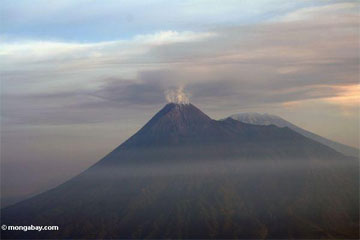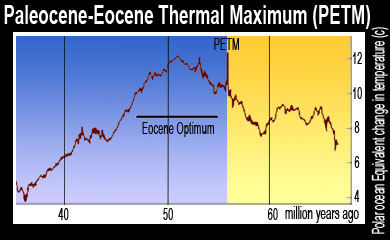Volcanoes linked to massive global warming 55M years ago
Volcanoes linked to massive global warming event
Rhett A. Butler, mongabay.com
April 26, 2007
Scientists have linked a sharp spike in ocean temperatures 55 million years ago to massive volcanic eruptions that created the North Atlantic Ocean when Greenland and northwestern Europe separated.
Writing in the current issue of the journal Science, geologists at Roskilde University in Denmark, Oregon State University and Rutgers, argue that intense volcanic activity occurred at the same time ocean temperatures jumped five to six degrees Celsius during the Paleocene-Eocene thermal maximum.
“That prehistoric volcanic activity released more than 2000 gigatonnes (billion metric tons) of carbon into the oceans and atmosphere in the form of methane and carbon dioxide — two potent greenhouse gases,” said Michael Storey, a geologist at Roskilde University in Denmark and lead author of the study. “The carbon probably came from the heating of earlier deposits of decayed organic matter — similar to deposits in the Atlantic and North Sea we tap today for oil and gas.”

Eruption in Java, Indonesia. Photo by R. Butler The Paleocene/Eocene Thermal Maximum (Chart by R. Butler of mongabay.com). Research published over the past year indicates that PETM climate change helped drive the evolution of modern primates by causing the dispersal of tarsier-like primates across the globe. |
The scientists used ocean sediment core samples from a layer of volcanic ash that occurs on the sea floor near East Greenland and the Faeroes Islands to come up with a precise date of the eruptions.
“Scientists have known of this major prehistoric global warming episode, called the Paleocene-Eocene thermal maximum, or PETM, for some time,” said Carl Swisher, professor of geological sciences at Rutgers. “Marine records document a sudden release of carbon dioxide, known as the carbon isotope excursion, accompanied with an increase in ocean acidity and the extinction of many deep-sea species. Now, for the first time, geologists have a precise correlation to link the sudden increase in volcanic activity and spike in greenhouse gases.”
The Paleocene-Eocene Thermal Maximum (PETM was marked by a rapid rise in greenhouse gases that heated Earth by roughly 9° F (5° C), in less than 10,000 years. The climate warming caused widespread changes including mass extinction in the world’s oceans due to acidification and shifts of plant communities due to changes in rainfall. The era helped set the stage for the “Age of Mammals,” which included the first appearance of modern primates and the spread of rhinos and the earliest known horse into new habitats.
Research published in Science last December said that the relationship between carbon dioxide and temperature during the PETM could help present day climatologists better forecast climate change.
While modern day warming is believed to be tied to anthropogenic sources such as the combustion of fossil fuels and the conversion of forests for agriculture, the authors of the new study say that the massive spike in atmospheric greenhouse gases 55 million years ago was tied to volcanic eruptions which released gases with lava flows and destabilized frozen methane deposits found in the deep ocean near continental margins and in the Arctic. The freed methane would have reacted with oxygen to produce huge amounts of carbon dioxide–the magnitude of which would have outweighed the cooling effect of particulate matter released into the atmosphere. Scientists are concerned that a parallel release of frozen methane hydrates today could trigger a similarly catastrophic climate event.
CITATION: M. Storey, R.A. Duncan, C.C. Swisher III (2007). Palocene-Eocene Thermal Maximum and the Opening of the Northeast Atlantic. Science Express Thursday 26 April 2007.
This article uses quotes and information from a Rutgers University news release and previous mongabay.com articles.
